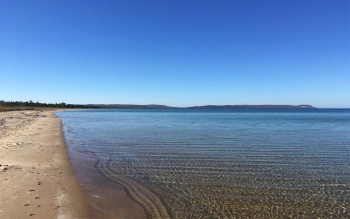
"Walking It Off"
Post-election reflections from the Sleeping Bear Dunes
By Christopher Schaberg | Dec 1 2016
The lakeshore before me is expansive: a 10-mile swoop of Lake Michigan coastline with no houses visible, only two public access points, and a backdrop of dense beech and maple forests that rise up from the pines and dunes below. I never get tired of this walk. In the distance, red foxes will dart down to the water and back to the cover of juniper before I get too close. Piping plovers and sandpipers dance at the water’s edge, mining the wet sand for insect larvae. It is late in the season for dragonflies, but one iridescent-bodied outlier clings uncertainly to a blade of dune grass, likely its last flight before the wind shifts to the north tomorrow and the first winter cold front pummels the peninsula.
Michigan's Sleeping Bear Dunes National Lakeshore is a stunning place, but I don’t want to romanticize it too much. The nearby towns are reliant on a tourist economy, especially in the summer months—thus creating a familiar, vexed dynamic between the stoic locals and lavish vacationers. The place itself is beautiful but can also be severe. Every year people die in the lake: from hypothermia after boating accidents, or from trying to swim in fierce rip currents. I’ve gotten lost here several times in the labyrinthine cedar swamps and in the thickest parts of the forested hills in midsummer, when the foliage blocks out the sunlight and disorients my sense of direction. The other day I ran across a mangled coyote carcass in a dogwood grove, apparently the result of some wild scuffle in the night. Like a crime scene, a foul scent lingered in the air, and branches were bent and torn. Sometimes the lakeshore seems more like a Cormac McCarthy novel than an Emersonian treatise on Nature.
Now on the beach I notice another uncanny object: a dead loon washed up on the sand, its feathers crumpled by the waves and its head flipped back in an unnatural comportment. This isn’t an anomaly—it’s the fourth one I’ve seen today. The national lakeshore has posted information on its website explaining that the recent die-off of loons along this lakeshore has been caused by botulism E outbreaks, which they are studying. It’s sad, as I’ve seen the loon population bloom here since I was a kid. When I was younger, it was rare to see them on the inland waters, but now when I go out fishing, I will usually see a group of loons nearby, working a cove with their diving fishing techniques, or performing their mad splashing mating rituals while I wade the opposite shoreline. One evening this past summer, my son and I were out in our canoe on a mirror-calm lake and we drifted to within 20 feet of three loons; when they made their haunting calls, from this close proximity the sounds had an altogether different affect than hearing them from afar, and my son got a kick out of the expression “laughing loons.”
Click here to read the whole article.
